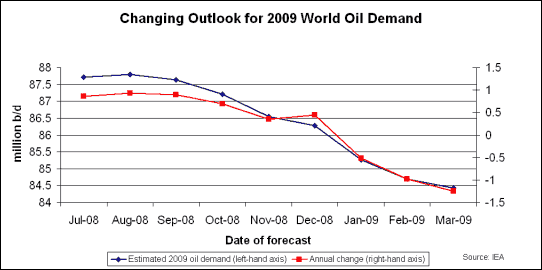One of the most obvious impacts of the financial crisis and ensuing global
economic slowdown on the oil sector has been to dent consumption in many
countries, but there have also been big changes to the supply outlook in
recent months.
Some of these changes are due directly to the credit crunch and the
difficulty companies face in securing money, but a bigger factor has been
the spectacular collapse in oil prices since last July's record levels and
what this means for anyone considering embarking on new upstream investment.
| One of the most obvious impacts of the financial crisis and ensuing global economic slowdown on the oil sector has been to dent consumption in many countries ... |
There is already clear evidence of oil field development work being either
delayed or canceled, prompting rare unanimity from major producers and
consumers about the potential threat to the supply/demand balance in the
coming months and years.
Changing outlook for 2009 world oil demand (million b/d)

Non-OPEC oil production is often seen as hard to forecast, with project
slippage and unexpected reservoir decline rates often meaning that actual
output comes in below anticipated levels.
As a result, initial forecasts are often revised downwards, as is the case
with the International Energy Agency's projections.
In July last year the IEA predicted that non-OPEC oil production would rise
by 640,000 b/d in 2009.
That expected growth has now disappeared, with the IEA now expecting output
to be virtually unchanged this year compared with 2008.
This would mean non-OPEC production will have fallen on average over the
four-year period starting 2006.
In some parts of the world the reasons for this decline are obvious.
UK output peaked years ago, as did Norway's, and it's also on the
way down in the mature onshore and shallow water areas of the US Gulf Coast
region.
Furthermore, the expected Caspian oil boom has filed to materialize yet,
with the exception of BP's mega-project at the ACG fields in Azerbaijan, and
Russian output fell last year for the first time in a decade, after years of
heady growth.
Another of the biggest growth areas in non-OPEC for much of this decade,
Angola, has now joined OPEC.
And while there have been some high-profile exploration successes in the
last year or two in countries like Brazil, this oil is still some way from
coming on stream.
Many of these trends were firmly established before anyone had heard the
words "credit crisis," but the events of the last few months have changed
the landscape dramatically for companies considering investment in the
upstream oil industry.
At the most basic level, debt financing, and to a large extent equity
financing, have been effectively ceased to exist as a means of raising
capital for many in the industry.
For the likes of ExxonMobil and its supermajor peers, their strong balance
sheets and large cashflow mean this is less of a problem, but for companies
further down the food chain it is presenting a much bigger hurdle they must
overcome to be able to finance new developments.
And even the mightiest of the oil companies have one big thing in common
with the smallest in the industry - they get the same price for their oil.
The slump in oil prices since the middle of last year, which has so far not
been accompanied by a similar fall in the costs of developing and producing
oil from new fields, has caused a wholesale re-evaluation of project
economics by everyone in the industry.
In high-cost areas such as the Canadian oil sands patch, this has caused
many would-be new projects to be put on hold.
And on a more general basis, companies sticking to their original capital
spending plans for this year are rapidly becoming the exception, as
boardrooms around the world react to the twin challenges of uncertain
project economics and a lack of available credit by choosing to spend less.
Warning voices have been coming from all quarters--including, for once, both
OPEC and the IEA--that this fall in investment could spell trouble in the
future and might even be sowing the seeds of a new oil price spike.
Market-watchers and companies alike are seemingly unanimous in their view
that the oil prices seen in recent weeks and months are simply not high
enough to cover the costs of developing reserves in the more remote or
technically different areas of the world.
A late March study by Cambridge Energy Research Associates said the fall in
oil prices since mid-2008 would cut medium-term supply growth in half,
saying that around 7.6 million b/d of potential new output capacity between
2009 and 2014 was now "at risk."
Whether or not the dwindling prospects of new supply growth lead to renewed
upward pressure on prices may well depend on how long oil demand remains in
the doldrums.
If a rapid rebound in global economic growth and oil consumption is not
accompanied by a more profitable environment for upstream investment in the
shape of higher prices and/or lower costs, then the supply/demand balance
could rapidly start to look tighter than it does at the moment.
You could argue that this balance is by its very nature cyclical, but that
doesn't mean anyone would welcome a repeat of last year's oil price
rollercoaster.
|